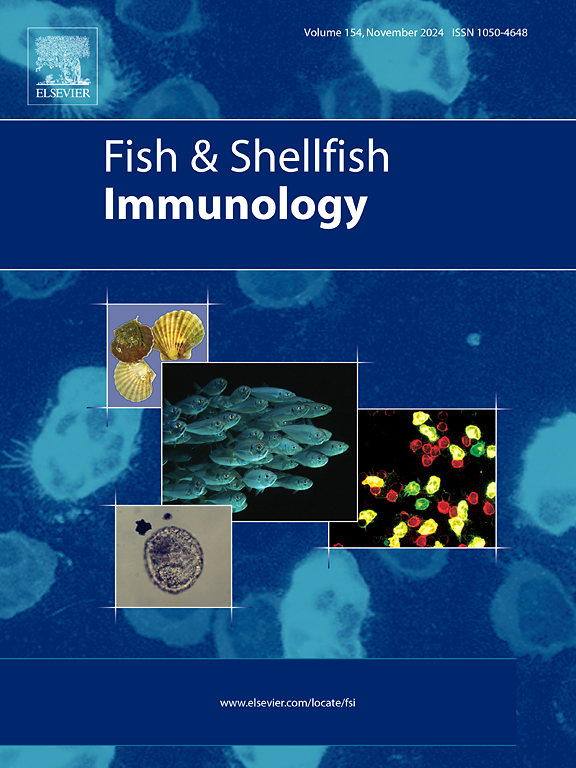Galectin-9 activates host immune response and improve immunoprotection of Onychostoma macrolepis against Aeromonas hydrophila infection
IF 4.1
2区 农林科学
Q1 FISHERIES
引用次数: 0
Abstract
Galectin-9 (Gal-9) belongs to a family of the glycan-binding proteins (GBPs) and is known to restrict bacterial activity via interacting with pathogen associated molecular pattern (PAMPs). However, the underlying immune mechanism of endogenous Gal-9 on fish against bacterial infection is still unclear. In this study, effects of Gal-9 from Onychostoma macrolepis (OmGal-9) on expression of immune-related genes were measured by HEK293T. The immune response of O. macrolepis with OmGal-9 overexpression to Aeromonas hydrophila (A. hydrophila) infection (1.65 × 108 CFU/mL) was evaluated by tissue bacterial load, fish survival rate and transcriptome analysis. The results showed that OmGal-9 displayed a punctate distribution in the nucleus and cytoplasm of HEK293T cells. Compared to cells transfected with the empty vector (EV group), recombinant plasmid pEGFP-Gal9 treatment (Gal9 group) significantly down-regulated the expression of immune-related genes TNFα, STAT3, MyD88, LCK, and p52 of HEK293T cells stimulated with LPS at 24 h, while up-regulated IκBα and caspase-1 (P < 0.05). The activities of catalase (CAT), superoxide dismutase (SOD), the total antioxidant capacity (T-AOC), alkaline phosphatase (AKP), acid phosphatase (ACP), and lysozyme (LZM) of O. macrolepis were significantly increased on 7 days in Gal9 group compared to EV group (P < 0.05). The bacterial load of liver, spleen, and kidney of O. macrolepis infected with A. hydrophila in Gal9 group at 24 h was significantly lower than that in EV group (P < 0.05), and the survival rate had increased from 15 % to 35 %. A comparative transcriptome analysis between the Gal9 and EV group identified 305 differentially expressed genes (DEGs). The analysis showed that OmGal-9 might play an important regulatory role in glycolysis/gluconeogenesis, fatty acid degradation, and ascorbate and aldarate metabolism. Moreover, the immune-related DEGs were predominantly enriched in eleven pathways, with the most important three of them being linked to innate immunity: NOD-like, C-type lectin and Toll-like receptor signaling pathway. Taking together, OmGal-9 can enhance the resistance of fish to bacterial diseases by improving immune system function and activating immune-related pathways.
Galectin-9能激活宿主免疫反应,并提高大蜗牛对嗜水气单胞菌感染的免疫保护能力。
Galectin-9(Gal-9)属于糖结合蛋白(GBPs)家族,已知可通过与病原体相关分子模式(PAMPs)相互作用来限制细菌的活动。然而,内源性 Gal-9 对鱼类抵抗细菌感染的免疫机制尚不清楚。本研究利用 HEK293T 测定了大鳞鲤的 Gal-9 (OmGal-9)对免疫相关基因表达的影响。通过组织细菌载量、鱼类存活率和转录组分析,评估了过表达 OmGal-9 的大菱鲆对嗜水气单胞菌(A. hydrophila)感染(1.65×108 CFU/mL)的免疫反应。结果表明,OmGal-9 在 HEK293T 细胞的细胞核和细胞质中呈点状分布。与转染空载体(EV)组相比,重组质粒 pEGFP-Gal9 处理组(Gal9)能显著下调 LPS 刺激下 HEK293T 细胞 24 h 的免疫相关基因 TNFα、STAT3、MyD88、LCK 和 p52 的表达,同时上调 IκBα 和 caspase1 的表达(P < 0.05)。与EV组相比,Gal9组O.macrolepis的过氧化氢酶(CAT)、超氧化物歧化酶(SOD)、总抗氧化能力(T-AOC)、碱性磷酸酶(AKP)、酸性磷酸酶(ACP)和溶菌酶(LZM)的活性在7天后显著增加(P<0.05)。Gal9组大菱鲆感染蚜蝇后24小时内肝、脾、肾的细菌量明显低于EV组(P<0.05),存活率从15%提高到35%。Gal9 组和 EV 组的转录组比较分析发现了 305 个差异表达基因(DEGs)。分析表明,OmGal-9 可能在糖酵解/葡萄糖生成、脂肪酸降解、抗坏血酸和醛酸代谢中发挥重要的调控作用。此外,免疫相关的 DEGs 主要富集在 11 个通路中,其中最重要的 3 个通路与先天免疫有关:NOD样、C型凝集素和Toll样受体信号通路。综合来看,OmGal-9 可通过改善免疫系统功能和激活免疫相关通路来增强鱼类对细菌性疾病的抵抗力。
本文章由计算机程序翻译,如有差异,请以英文原文为准。
求助全文
约1分钟内获得全文
求助全文
来源期刊

Fish & shellfish immunology
农林科学-海洋与淡水生物学
CiteScore
7.50
自引率
19.10%
发文量
750
审稿时长
68 days
期刊介绍:
Fish and Shellfish Immunology rapidly publishes high-quality, peer-refereed contributions in the expanding fields of fish and shellfish immunology. It presents studies on the basic mechanisms of both the specific and non-specific defense systems, the cells, tissues, and humoral factors involved, their dependence on environmental and intrinsic factors, response to pathogens, response to vaccination, and applied studies on the development of specific vaccines for use in the aquaculture industry.
 求助内容:
求助内容: 应助结果提醒方式:
应助结果提醒方式:


